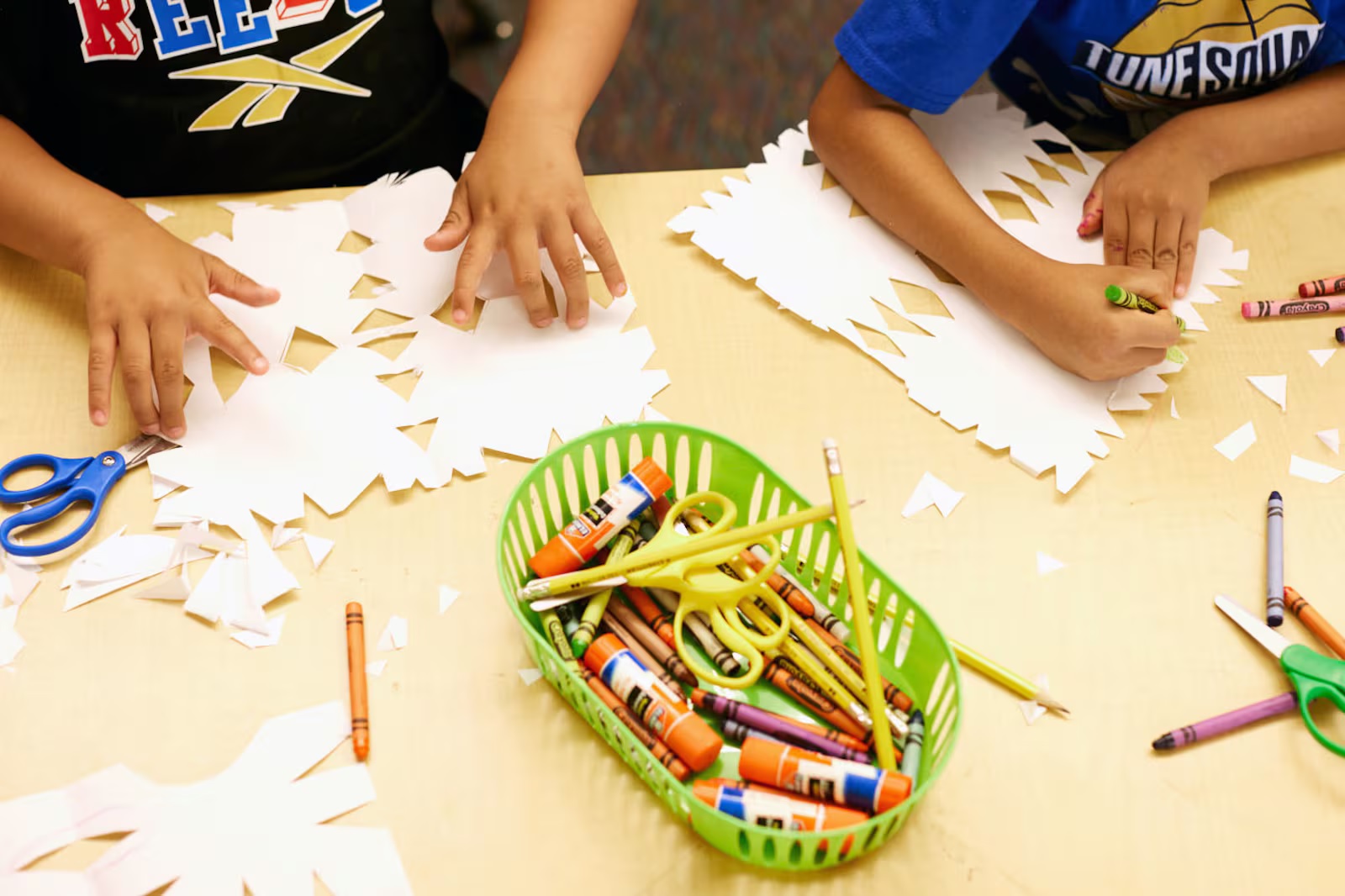This story was originally published by Chalkbeat. Sign up for their newsletters.
Jamie Epps did not expect to spend a lot of her own money on school supplies when she decided to take a teaching job for the fall of 2023.
Her mother convinced her to teach as a source of income while Epps attended nursing school. A retired teacher herself, Epps’ mom also gave her some advice.
“She told me I probably would have to buy classroom decorations with my money, like bulletin boards and posters,” Epps said. “But that is not what happened.”
Epps was surprised when she first stepped into her Florida classroom and found there were no supplies available: no paper, no staplers, not even dry-erase markers. In the following months, she spent over $6,000 to stock basic supplies and materials to teach science.
Epps’s experience on her first days as a teacher is an extreme but generally familiar version of what almost every American teacher goes through. The National Teacher and Principal Survey reported that 95% of public school teachers reported spending their own money to buy supplies for the classroom in the most recent data available — without getting reimbursed.
Many teachers can deduct up to $300 in classroom expenses from their taxes, but they often spend way more than that. In a survey conducted by the crowdfunding platform DonorsChoose of 2,500 teachers who used the platform, educators reported spending $610 on average for this school year.
Like Epps, most teachers spend most of their money on essential materials such as paper, pencils, and markers. Chalkbeat asked educators to share how much they spend on school supplies and what they spend it on. More than 120 teachers across the country responded.
They reported spending anywhere from $65 to $6,000. Their purchases included items to make students more comfortable and learning more enjoyable. Many said they expected to spend more on students this year than last.
Below, some of these teachers share in their own words how and why they spend money out of their own pockets on their classrooms.
A comfortable place for students is teacher’s goal
Judy Hall is an English teacher at Barringer High School in Newark, New Jersey
I’ve been teaching for 25 years and am used to spending my own money. Part of my expenses are resources for teaching: I subscribe to some newspapers since I use articles to teach English, and I buy books for my classroom’s library.
I also buy décor items: It is important that the classroom is comfortable and cozy for the students and for myself, since I spend most of my day there. Many of my students are food insecure, so I try to keep snacks and protein bars with me. I also keep menstrual products, a sewing kit, a full body mirror, and first aid supplies.
Last year, I paid around $1,500, and I expect to spend the same amount this year. It is more than I was used to, mainly because the price of food has increased so much.
I like that kids feel like they can drop by for additional help. I am a very strict teacher. In my class, everyone has to follow the rules and do their work. Having this kind of homey experience helps build a stronger connection.
Students with disabilities need appropriate equipment
Ellen Brody-Kirmss is a special education teacher at Clara Barton High School, in Brooklyn, New York
I have been teaching for 19 years and, in the beginning, I spent much more money than I do now. I didn’t have lesson plans, or a curriculum, or even my own classroom. Because of that, I had to buy a rolling cart that I could bring from one place to another.
I am a special education teacher, and both my parents were, too. Back in their day, which is ancient history now, the materials that would help the students they were teaching weren’t available: They had to be inventive. I am part of that tradition.
This year, I am teaching a course to students with intellectual disabilities who are part of the ACES [Academics, Career, and Essential Skills] Program. In high school, there’s nothing in ready-made equipment appropriate for them, and each student has specific needs. I bought calculators, headphones, different writing instruments, and tools to help kids read. I got a lot of pictures and word games for students too, because they struggle with discourse. I expect to spend up to $800 from my own pocket this year.
I’m trying to get the school to buy a particular online curriculum for math. If they don’t and it’s cheap enough, I’ll buy it, but I don’t want to have to do that.
Teacher wants classroom to be ‘best place on Earth’
Mindy Gunderson is a first grade teacher at Hayden Canyon Charter in Hayden, Idaho
This year, I spent about $2,000 to get started. My biggest expense was in supplies for an independent workstation and classroom decorations. When kids finish their work, they can pick an activity from a chart where I list the independent workstations: There are building pieces, sensory boards, STEM toys, math manipulatives, and so on.
I don’t know if everybody agrees with me, but these items are essential to me. I wholeheartedly believe that learning takes place through play. So, in a first-grade classroom, I want to incorporate as much play as possible. Through this, kids also develop a sense of community because they get together to play, build things, and do work at the stations.
I want students to love coming to school. When I incorporate things they enjoy, they want to go to school and learn. Once that happens, I can teach them anything. And if that means I have to invest a little bit of my money, I’m OK with that because I want the relationship and my classroom to be the best place on Earth.
‘I don’t ever want to go back to teaching’
Jamie Epps is a science teacher at Hialeah Senior High School in Hialeah, Florida
On my first day as a teacher, I didn’t bring anything because I heard teachers are given a little starter pack. My mom, who had been a teacher for over 20 years, also told me that I would probably have to buy classroom decorations, like a bulletin board.
That’s not the situation I lived in when I walked into the classroom: there were no pencils, paper, or markers. I had to buy everything, from staplers to printer ink. Over the 2023-2024 school year, I spent over $6,000, including materials for science experiments. I bought a class pet, a rabbit, and a fish tank so that we could study marine science.
This year, the district provided a little kit with a dry-erase marker, some hall passes, and a package of post-its. I am finishing nursing school, and I don’t ever want to go back to teaching after this experience.
Teacher salary raises headed back into classroom costs
Polly Franklin is a Spanish teacher at Lowell Senior High School in Lowell, Indiana
As a Spanish teacher, most of what I spend out of my own money goes to subscriptions to technology that give my students the best chance of learning and save me an abundance of time. These subscriptions can add up — I spent about $300 last year and am thinking I’ll spend closer to $500 this school year.
There’s a lot on the Internet for Spanish educators, but I don’t have time to sift through all the materials in the world to find ones appropriate to my class. The ones I pay for on my own include Zambombazo, a website [specifically] for Spanish teachers, that gives me games and authentic songs and lyrics to bring into my classroom.
[Related: AI pioneers want bots to replace human teachers – Here’s why that’s unlikely]
Like all teachers, my time outside of school is stretched thin during the school year. I am a full-time caretaker of a family member and I’m getting a master’s degree. Even though I spend my own money reluctantly, I know it’s worth it for the kids’ enjoyment of lessons and also for my own sanity. It is sad to me that, for a lot of us, any small salary raise we get seems to just go right back into the classroom.
Classroom supplies take priority over helping student clubs
Ceretta Morris is a Language Arts and social studies teacher at John D. Shoop Academy in Chicago
This year has been particularly challenging. In the past, I taught only one grade level; now, I teach three. This has led to me needing a wider variety of materials and resources. I teach four classes of 25 kids daily, so I buy a lot of stuff. I ordered a box of 500 pre-sharpened pencils, heavy-duty pencil sharpeners, folders, and boxes of copy paper.
I’m the queen of taking advantage of all available donations: Donor Choose, AdoptAClassroom, GoFundMe … I do all of those, but I still spent about $600 out of my pocket. I also tried to put some of the material in a supply list, but getting middle school parents to shop for school supplies is hard.
[Related: Q&A: Why this Memphis ELA teacher helped his students start a farmer’s market]
If I didn’t have to spend money on essential supplies, I would love to support the funding for our school clubs. I co-sponsor our school’s Junior Beta Club, which [gathers] high achieving students to perform services to the community, and I see how much funding they still need.
***
Wellington Soares is Chalkbeat’s national education reporting intern based in New York City.
Caroline Bauman is Chalkbeat’s deputy managing editor for engagement.
Chalkbeat is a nonprofit news site covering educational change in public schools.




























